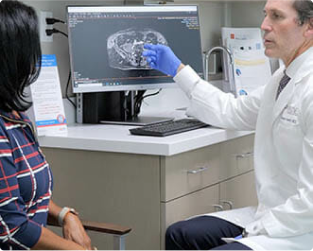Surgical Dialysis Access
Surgical Access Procedures
This is a temporary option for hemodialysis, where Hemodialysis (HD) catheters serve as temporary access points. They provide direct access to the bloodstream and have a high infection rate, which is why they are used as a temporary solution. The ultimate goal is for our patients to eventually have long-term safer access like an AV fistula/graft or a peritoneal catheter, HD catheters are only placed when a patient is yet to have permanent access or when the permanent access is being fixed or has stopped working.
SURGICAL PD CATHETER PLACEMENT
PD catheter surgery is considered a minor operation for most patients and complications are often rare. Catheter placement can be done under general anesthesia and usually takes less than one hour. Most people are able to go home the same day. Surgery is typically performed by a specialist at a hospital, but there are some kidney doctors (nephrologists) and radiologists who are also trained to place PD catheters.
PERCUTANEOUS PD CATHETER PLACEMENT
Many vascular access centers perform percutaneous catheter placement, which is far less invasive than surgery. Percutaneous catheter placement is performed using an imaging technique (called fluoroscopy) that uses X-rays to help your vascular specialist view the inside of your abdomen. This procedure requires only local anesthesia and sedation, no general anesthesia is used. You get to go home the same day.
Your vascular specialist begins by using a fine needle to make a series of small punctures in your skin to access the peritoneum. The PD catheter is then passed through a small tunnel in your belly into the peritoneum & secured in place.
Fistula creation starts with a vein mapping ultrasound, where you undergo a physical examination along with ultrasound diagnostics. These tests determine whether your arteries are sufficiently healthy to support a fistula. An angiogram can also be used to gauge the size and depth of your veins and arteries. If you pass the tests and are judged to be a candidate for a fistula or graft, then an appointment is made for a fistula or graft creation at your local hospital. Our vascular surgeon will perform the procedure at the hospital and follow up with your care at our private clinic.
The actual process starts with a specialist administering local anesthesia on the identified access site. The surgeon then makes an incision that gives access to the blood vessels, a surgical connection between a vein and an artery are made. For a graft, a connection is made using a synthetic tube instead of your actual vein and artery. As a result of the connection, blood flows from the artery to the vein, which increases the blood flow, the vein enlarges, and its walls thicken.
After its creation, the AV fistula or graft is given weeks to months in some cases to mature to the point where it can be used safely for hemodialysis at your dialysis center.
Contact Us Today


Our Vascular Disease Physicians
The physicians at Pedes Orange County devote their lives to saving limbs and minimizing pain. Our conveniently located, state-of-the-art facility is designed for your comfort and utilizes cutting-edge technology to provide minimally invasive treatments. Our vascular specialists are board-certified and some of the best in Southern California. Personable staff members make every visit a positive experience, with short wait times and an efficient, streamlined process that ensures you leave feeling educated and confident that you are in good hands.

J. Joseph Hewett, M.D.
Vascular Specialist

Neil K. Goldstein, M.D.
Vascular Specialist

Derrick Tran, MD
Vascular Specialist

Mohammad Jaber, M.D.
Vascular Specialist
What to Expect from Your Visit to Pedes

Ultrasound
Advanced ultrasound-guided examination techniques will be used to visualize the veins, arteries, or both, in your legs. This is often used in the diagnostic process to detect the presence and extent of disease.

Consult
Once we review the results of your diagnostic tests, our physicians will collaborate with you to develop a personalized treatment plan, ensuring the best course of treatment for your specific condition.

Treatment
Your treatment plan will be personalized to you and your individual needs. At Pedes, we specialize in minimally invasive procedures and nonsurgical treatments, all of which are performed by our dedicated vascular physicians within the comfort of our state-of-the-art facility.

Follow up
We ensure our patients receive continuous care and support with regular follow-up visits. Each follow-up visit is scheduled at the time of your in-office appointment. Should you have a concern between
appointments, we encourage you to call our office and get scheduled at any time.

Treatment Options
Learn more about our treatment options

What to Expect
Learn more about our what to expect

Vascular Disease
Return to the interactive body page




